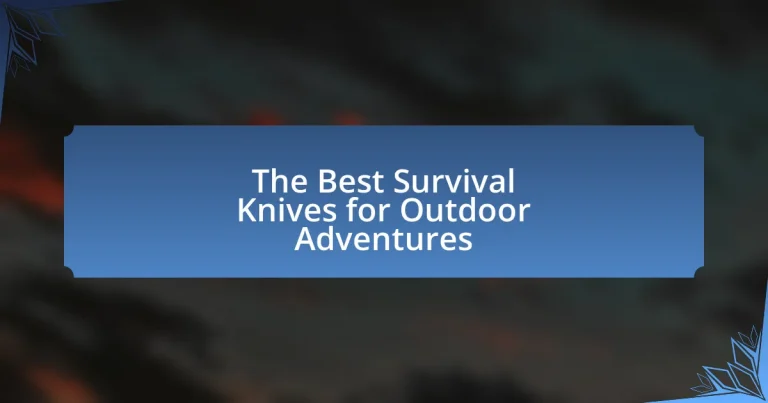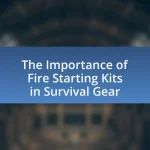The article focuses on the best survival knives for outdoor adventures, highlighting top models such as the ESEE-6, Morakniv Companion, and Benchmade Bushcrafter. It provides guidance on selecting the right survival knife by emphasizing key features like blade material, size, and design, as well as the importance of ergonomics and functionality. The article also discusses the significance of a survival knife in various outdoor scenarios, the differences between fixed-blade and folding knives, and the maintenance practices necessary to ensure longevity and performance. Additionally, it reviews popular brands and their unique qualities, along with tips for enhancing the user experience with survival knives.
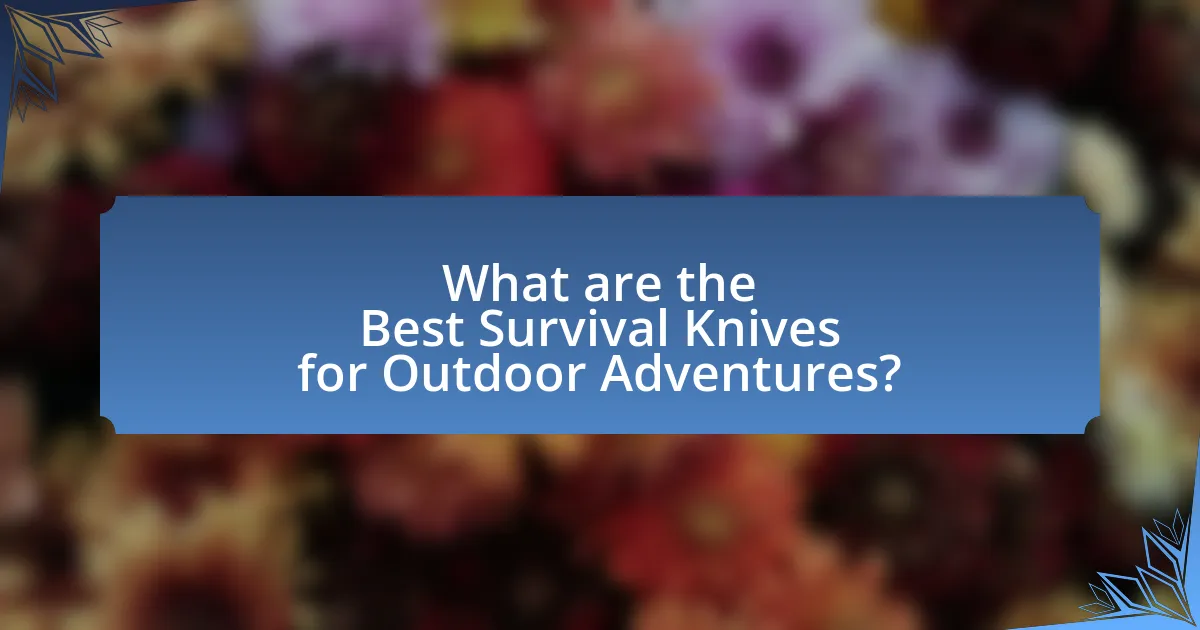
What are the Best Survival Knives for Outdoor Adventures?
The best survival knives for outdoor adventures include the ESEE-6, Morakniv Companion, and Benchmade Bushcrafter. The ESEE-6 features a 6.5-inch blade made of high-carbon steel, known for its durability and edge retention, making it ideal for heavy-duty tasks. The Morakniv Companion is a budget-friendly option with a 4.1-inch stainless steel blade, praised for its versatility and ease of use in various outdoor scenarios. The Benchmade Bushcrafter, with its 4.4-inch S30V stainless steel blade, is recognized for its high-quality materials and ergonomic design, providing excellent performance in survival situations. These knives are widely recommended by outdoor enthusiasts and survival experts for their reliability and functionality in the field.
How do you choose the right survival knife?
To choose the right survival knife, prioritize blade material, size, and design. High-carbon stainless steel is preferred for its durability and edge retention, while a blade length of 4 to 6 inches offers versatility for various tasks. A full tang construction enhances strength and balance, making the knife more reliable in survival situations. Additionally, consider features like a comfortable grip and a fixed blade for ease of use. These specifications are supported by expert recommendations in survival gear reviews, emphasizing the importance of quality materials and ergonomic design for effective performance in outdoor adventures.
What features should you look for in a survival knife?
When selecting a survival knife, prioritize features such as blade material, blade design, handle ergonomics, and additional functionalities. High-quality blade materials like stainless steel or carbon steel ensure durability and resistance to corrosion, which is essential for survival situations. A fixed blade design typically offers greater strength and reliability compared to folding knives, making it preferable for heavy-duty tasks. Ergonomic handles provide a secure grip, reducing the risk of slippage during use, which is crucial for safety and efficiency. Additional functionalities, such as a built-in fire starter or a serrated edge, can enhance the knife’s versatility in various survival scenarios. These features collectively contribute to the knife’s effectiveness in outdoor adventures.
How does blade material affect knife performance?
Blade material significantly affects knife performance by influencing factors such as edge retention, corrosion resistance, and ease of sharpening. For instance, high-carbon stainless steel offers excellent edge retention and corrosion resistance, making it suitable for outdoor environments, while ceramic blades provide exceptional sharpness but can be brittle. Research indicates that different materials, like D2 tool steel, maintain sharpness longer than softer steels, which require more frequent sharpening. Thus, the choice of blade material directly impacts the knife’s effectiveness in survival situations.
Why is a survival knife essential for outdoor adventures?
A survival knife is essential for outdoor adventures because it serves multiple critical functions that enhance safety and preparedness. This tool can be used for tasks such as cutting rope, preparing food, building shelter, and performing first aid, making it a versatile asset in survival situations. According to a study by the Outdoor Industry Association, 70% of outdoor enthusiasts consider a knife a fundamental piece of gear, highlighting its importance in emergency scenarios. The ability to efficiently perform these tasks can significantly increase the chances of survival in the wilderness.
What survival situations can a knife help with?
A knife can help with various survival situations, including food preparation, shelter building, and self-defense. In food preparation, a knife is essential for cutting and processing game or plants, which is crucial for sustenance in the wild. For shelter building, a knife aids in cutting branches and materials to create a protective structure against the elements. Additionally, in self-defense scenarios, a knife can serve as a tool for protection against potential threats. These functions highlight the knife’s versatility and importance in survival contexts.
How does a survival knife compare to other outdoor tools?
A survival knife is a versatile tool that often outperforms other outdoor tools in critical survival situations. Unlike axes or saws, which are primarily designed for cutting wood, a survival knife can perform multiple functions such as cutting, slicing, carving, and even self-defense. Its compact size allows for easy portability, making it more accessible than larger tools when immediate action is required. Additionally, survival knives typically feature durable materials and designs that enhance their effectiveness in harsh environments, providing reliability that may not be present in other outdoor tools. For instance, a study by the Outdoor Industry Association indicates that knives are among the top three essential tools for outdoor survival, highlighting their importance in emergency scenarios.
What are the top brands of survival knives?
The top brands of survival knives include Gerber, KA-BAR, Benchmade, ESEE, and SOG. Gerber is known for its innovative designs and durability, while KA-BAR has a long-standing reputation for producing reliable combat and survival knives. Benchmade is recognized for its high-quality materials and craftsmanship, ESEE specializes in survival and outdoor knives with a focus on practicality, and SOG offers a variety of tactical and outdoor knives that are well-regarded for their performance. These brands are frequently recommended by outdoor enthusiasts and survival experts for their reliability and effectiveness in various survival situations.
What makes each brand unique in terms of quality and design?
Each brand of survival knives is unique in terms of quality and design due to their specific materials, craftsmanship, and intended use. For instance, brands like Benchmade emphasize high-quality steel and ergonomic designs, ensuring durability and comfort during extended use. In contrast, brands such as Morakniv focus on lightweight materials and simplicity, making their knives ideal for outdoor enthusiasts who prioritize portability. Additionally, brands like ESEE are known for their rugged construction and survival-oriented features, catering to those who require reliability in extreme conditions. These distinctions in materials and design philosophies contribute to the overall uniqueness of each brand in the survival knife market.
How do customer reviews influence brand reputation?
Customer reviews significantly influence brand reputation by shaping public perception and trust. Positive reviews enhance a brand’s credibility, leading to increased customer loyalty and sales, while negative reviews can damage reputation and deter potential buyers. According to a study by BrightLocal, 87% of consumers read online reviews for local businesses, and 79% trust online reviews as much as personal recommendations. This demonstrates that customer feedback directly impacts how brands are viewed in the marketplace, particularly in competitive sectors like outdoor gear.
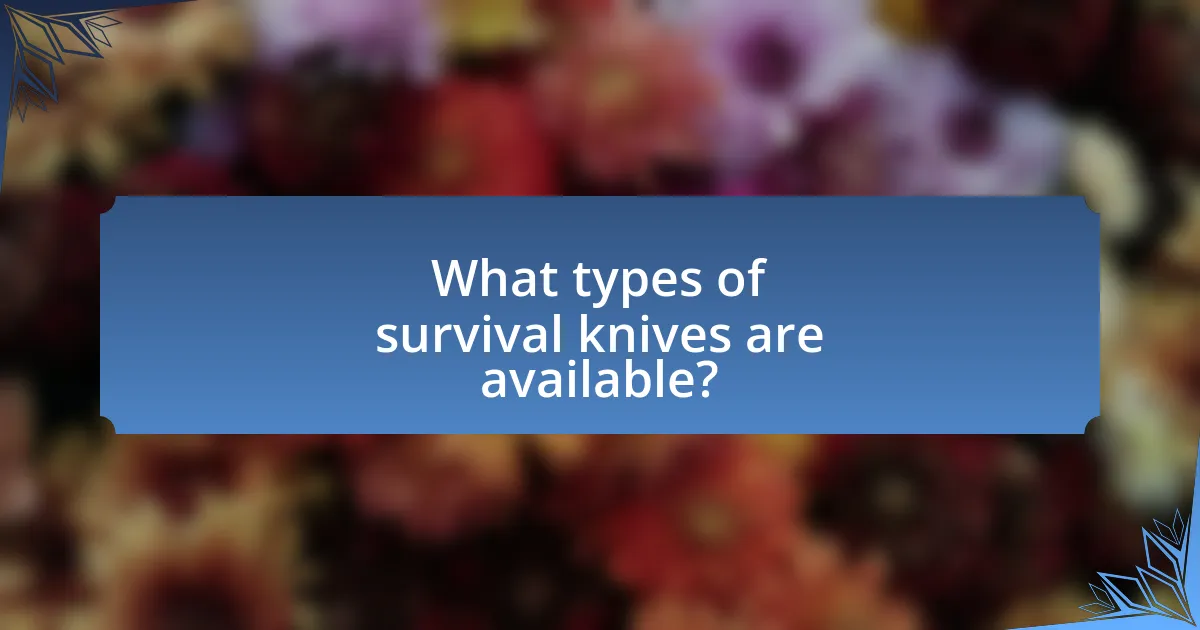
What types of survival knives are available?
There are several types of survival knives available, including fixed-blade knives, folding knives, multi-tools, and tactical knives. Fixed-blade knives are known for their strength and durability, making them ideal for heavy-duty tasks. Folding knives offer portability and convenience, allowing for easy storage and transport. Multi-tools combine various functions, providing versatility for different survival situations. Tactical knives are designed for combat and self-defense, often featuring serrated edges and robust construction. Each type serves specific purposes, catering to various outdoor adventure needs.
What are fixed blade survival knives?
Fixed blade survival knives are robust, non-folding knives designed for outdoor survival situations. These knives typically feature a full tang construction, which means the blade extends through the handle, providing enhanced strength and durability. Their design allows for a variety of tasks such as cutting, chopping, and carving, making them essential tools for wilderness survival. The fixed blade design eliminates the risk of the blade accidentally folding during use, ensuring safety and reliability in critical situations.
What advantages do fixed blade knives offer in survival situations?
Fixed blade knives offer superior durability and reliability in survival situations. Their robust construction allows for heavy-duty tasks such as chopping, slicing, and prying, which are essential for building shelters, preparing food, and crafting tools. Unlike folding knives, fixed blade knives do not have moving parts that can fail under stress, ensuring consistent performance. Additionally, fixed blade knives typically feature a full tang design, providing better balance and control during use. This design also enhances the knife’s strength, making it suitable for rigorous outdoor activities. The lack of a folding mechanism simplifies maintenance and cleaning, which is crucial in survival scenarios where hygiene can impact health.
What are some popular models of fixed blade survival knives?
Some popular models of fixed blade survival knives include the ESEE-6, Ka-Bar Becker BK2, and Morakniv Companion. The ESEE-6 is known for its durability and versatility, featuring a 6.5-inch blade made from high-carbon steel, which is ideal for various survival tasks. The Ka-Bar Becker BK2 is a robust knife with a 5.25-inch blade designed for heavy-duty use, making it a favorite among outdoor enthusiasts. The Morakniv Companion, while more affordable, offers a 4.1-inch blade made from Swedish stainless steel, providing excellent performance for its price. These models are widely recognized for their reliability and effectiveness in survival situations.
What are folding survival knives?
Folding survival knives are compact, portable cutting tools designed for outdoor survival situations, featuring a blade that folds into the handle for safety and ease of transport. These knives typically include durable materials, such as stainless steel for the blade and robust polymers or metals for the handle, ensuring they can withstand harsh conditions. Their design allows for quick deployment and secure locking mechanisms, making them versatile for various tasks like food preparation, shelter building, and self-defense. The practicality of folding survival knives is evidenced by their widespread use among outdoor enthusiasts, campers, and survivalists, highlighting their importance in emergency preparedness.
How do folding knives differ from fixed blade knives?
Folding knives differ from fixed blade knives primarily in their design and functionality; folding knives have a blade that folds into the handle, while fixed blade knives feature a blade that is permanently fixed and does not retract. This design difference affects their portability, with folding knives being more compact and easier to carry, making them suitable for everyday use and outdoor adventures where space is limited. In contrast, fixed blade knives typically offer greater strength and durability, as they lack moving parts that can wear out or fail, making them ideal for heavy-duty tasks in survival situations.
What are the benefits of carrying a folding survival knife?
Carrying a folding survival knife offers several benefits, including portability, versatility, and safety. The compact design allows for easy storage and transport, making it convenient for outdoor adventures. Versatility is another key advantage, as folding survival knives can perform various tasks such as cutting, slicing, and even self-defense, adapting to different situations. Additionally, the folding mechanism enhances safety by reducing the risk of accidental injury when not in use, as the blade can be securely tucked away. These features make folding survival knives an essential tool for outdoor enthusiasts.
What specialized survival knives exist?
Specialized survival knives include fixed-blade knives, folding knives, multi-tools, and tactical knives. Fixed-blade knives, such as the Ka-Bar Becker BK2, are known for their durability and strength, making them ideal for heavy-duty tasks. Folding knives, like the Benchmade Griptilian, offer portability and ease of use while still providing reliable cutting capabilities. Multi-tools, such as the Leatherman Wave, combine various tools in one device, enhancing versatility in survival situations. Tactical knives, exemplified by the SOG Seal Pup, are designed for combat and survival, featuring robust construction and specialized features. Each type serves distinct purposes, ensuring preparedness for various outdoor challenges.
What features do tactical survival knives have?
Tactical survival knives typically feature a robust blade made from high-carbon stainless steel, ensuring durability and resistance to corrosion. These knives often have a full-tang construction, which provides strength and stability during heavy use. Additionally, tactical survival knives usually include a serrated edge for versatile cutting capabilities and a non-slip grip handle for secure handling in various conditions. Many models also incorporate a sheath for safe storage and portability, and some may feature additional tools like a fire starter or glass breaker, enhancing their utility in survival situations.
How do multi-tool survival knives enhance functionality?
Multi-tool survival knives enhance functionality by integrating multiple tools into a single device, allowing users to perform various tasks efficiently. These knives typically combine features such as blades, screwdrivers, can openers, and pliers, which provide versatility in outdoor situations. For instance, a study by the American Outdoor Association highlights that multi-tool knives can reduce the need for carrying multiple separate tools, thus minimizing weight and maximizing utility during outdoor adventures. This multifunctionality is crucial for survival scenarios where space and resources are limited.
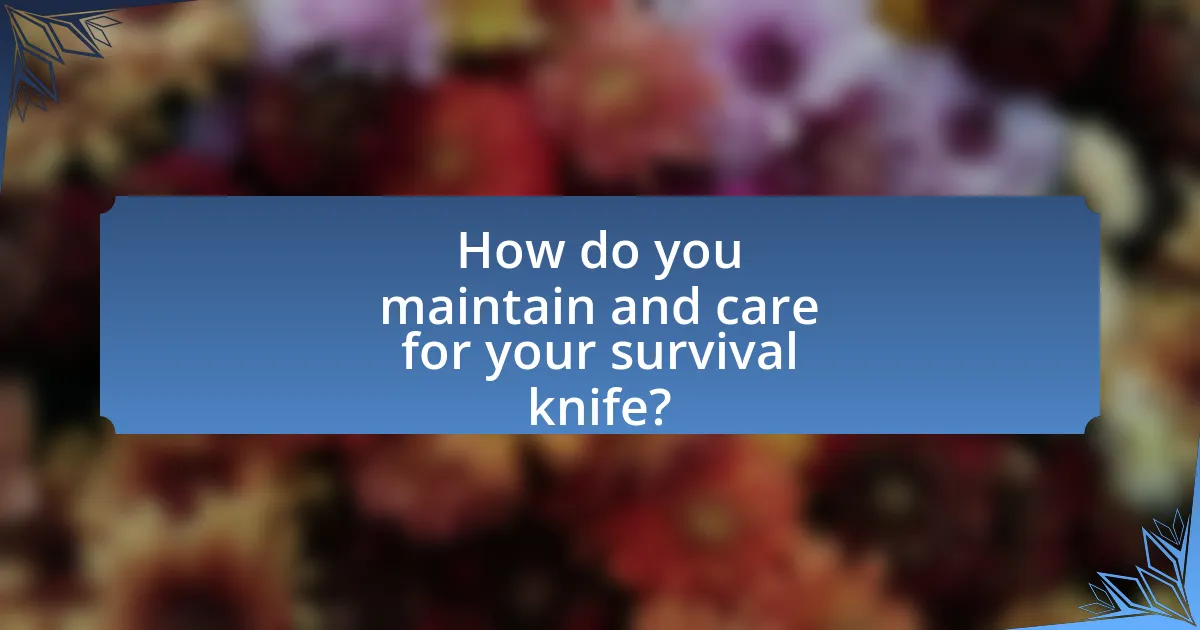
How do you maintain and care for your survival knife?
To maintain and care for your survival knife, regularly clean the blade with soap and water, ensuring it is free from dirt and debris. After cleaning, dry the knife thoroughly to prevent rust, especially if it has a carbon steel blade, which is more prone to corrosion. Additionally, apply a light coat of oil, such as mineral oil or gun oil, to the blade to protect it from moisture and oxidation. Regularly sharpen the blade using a whetstone or sharpening tool to maintain its cutting edge, as a dull knife can be dangerous and less effective in survival situations. Proper storage in a dry place, preferably in a sheath, will also help protect the knife from damage and environmental factors.
What are the best practices for knife maintenance?
The best practices for knife maintenance include regular cleaning, proper sharpening, and safe storage. Cleaning knives after each use prevents corrosion and buildup of food particles, which can damage the blade. Sharpening should be done using a whetstone or honing rod to maintain the edge, ideally every few uses, depending on the knife’s material and usage frequency. Safe storage in a sheath or magnetic strip protects the blade from damage and keeps it out of reach of children. These practices ensure longevity and optimal performance of survival knives, which are essential for outdoor adventures.
How often should you sharpen your survival knife?
You should sharpen your survival knife every few uses or whenever it shows signs of dullness. Regular maintenance ensures optimal performance, as a sharp knife is essential for effective cutting, slicing, and other survival tasks. According to knife care experts, a survival knife should be sharpened after every 5 to 10 uses, depending on the materials it encounters and the intensity of use. This frequency helps maintain the blade’s edge and prolongs its lifespan, ensuring reliability in critical situations.
What cleaning methods are safe for different blade materials?
Cleaning methods safe for different blade materials include using warm soapy water for stainless steel blades, which prevents rust and corrosion; vinegar or baking soda for carbon steel blades, as these substances effectively remove rust without damaging the metal; and a damp cloth for ceramic blades, which avoids scratches and preserves the blade’s integrity. Each method is tailored to the specific properties of the materials, ensuring longevity and performance. For instance, stainless steel is resistant to corrosion, making soapy water a safe choice, while carbon steel is prone to rust, necessitating the use of acidic or abrasive cleaners like vinegar or baking soda.
What common mistakes should you avoid with your survival knife?
Common mistakes to avoid with your survival knife include using it for tasks it is not designed for, such as prying or hammering, which can damage the blade or handle. Additionally, neglecting to maintain the knife, including regular sharpening and cleaning, can lead to decreased performance and safety risks. Failing to store the knife properly, such as leaving it exposed to moisture, can cause rust and deterioration. Lastly, not familiarizing yourself with the knife’s features and limitations can result in ineffective use during critical situations. These practices are essential for ensuring the longevity and effectiveness of a survival knife in outdoor adventures.
How can improper storage affect your knife’s longevity?
Improper storage can significantly reduce a knife’s longevity by exposing it to moisture, which leads to rust and corrosion. When knives are stored in damp environments or without protective sheaths, the metal can deteriorate over time, compromising the blade’s integrity and sharpness. Additionally, storing knives loosely in drawers can cause blade nicks and dulling from contact with other utensils. Proper storage methods, such as using magnetic strips, sheaths, or dedicated knife blocks, help maintain the blade’s condition and extend its usable life.
What are the risks of using a dull knife in survival situations?
Using a dull knife in survival situations significantly increases the risk of injury and reduces effectiveness in critical tasks. A dull blade requires more force to cut, which can lead to slips and accidents, resulting in cuts or injuries to the user. Additionally, a dull knife is less effective for essential survival tasks such as preparing food, building shelter, or making fire, which can compromise safety and survival chances. Studies show that sharp knives reduce the likelihood of accidents; for instance, a study published in the Journal of Safety Research indicates that sharp tools lead to fewer injuries in both professional and outdoor settings. Therefore, the risks associated with using a dull knife include increased injury potential and decreased survival efficiency.
What tips can enhance your experience with survival knives?
To enhance your experience with survival knives, prioritize proper maintenance and usage techniques. Regularly sharpen the blade to ensure optimal cutting performance, as a dull knife can lead to accidents and inefficiency. Additionally, familiarize yourself with various knife grips and techniques for different tasks, such as slicing, carving, and prying, to maximize versatility. Understanding the specific materials and design of your knife can also improve its handling and effectiveness in survival situations. For instance, knives made from high-carbon steel offer better edge retention and durability compared to stainless steel, making them preferable for heavy-duty tasks.
